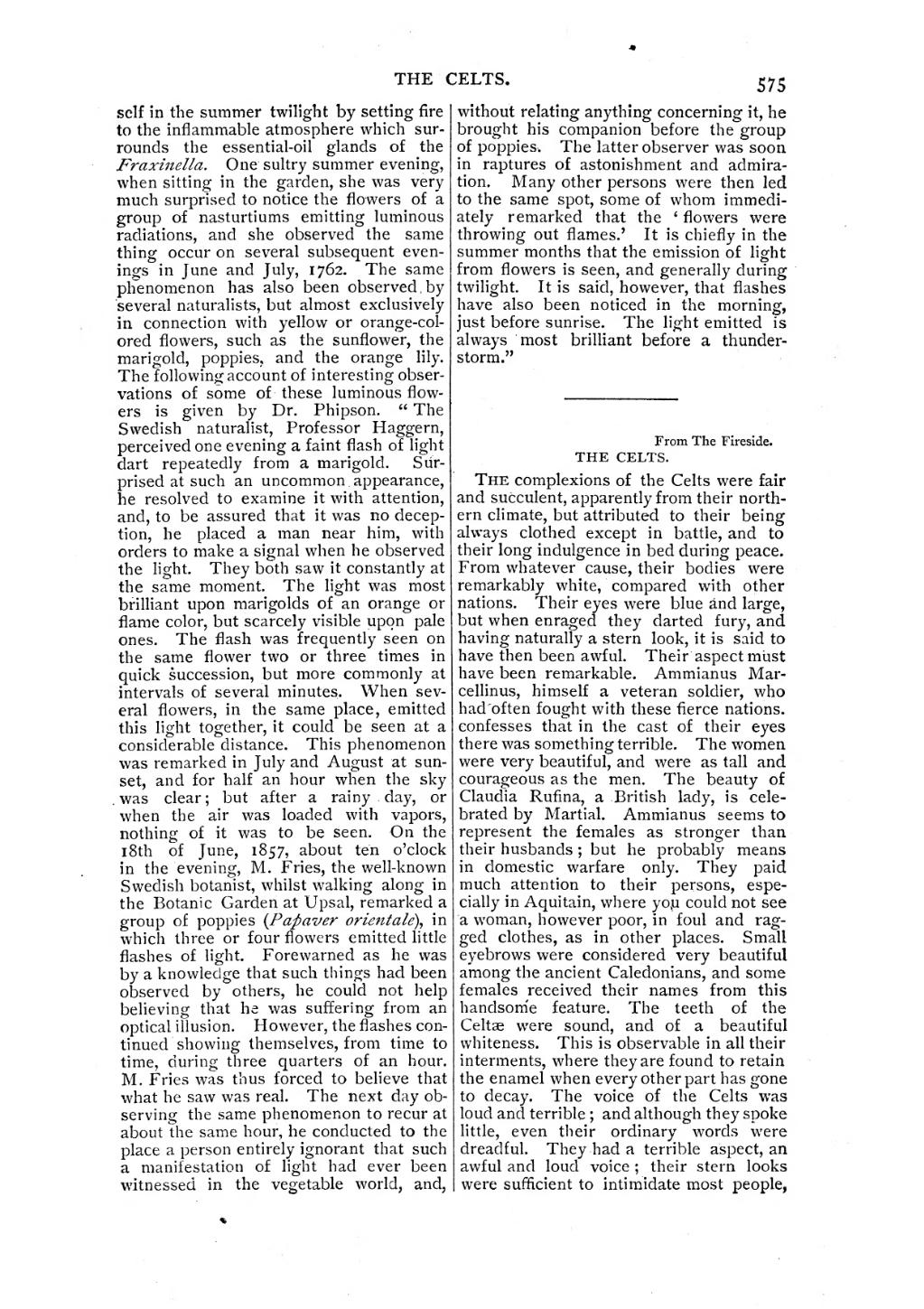self in the summer twilight by setting fire to the inflammable atmosphere which surrounds the essential-oil glands of the Fraxinella. One sultry summer evening, when sitting in the garden, she was very much surprised to notice the flowers of a group of nasturtiums emitting luminous radiations, and she observed the same thing occur on several subsequent evenings in June and July, 1762. The same phenomenon has also been observed, by several naturalists, but almost exclusively in connection with yellow or orange-colored flowers, such as the sunflower, the marigold, poppies, and the orange lily. The following account of interesting observations of some of these luminous flowers is given by Dr. Phipson. "The Swedish naturalist, Professor Haggern, perceived one evening a faint flash of light dart repeatedly from a marigold. Surprised at such an uncommon appearance, he resolved to examine it with attention, and, to be assured that it was no deception, he placed a man near him, with orders to make a signal when he observed the light. They both saw it constantly at the same moment. The light was most brilliant upon marigolds of an orange or flame color, but scarcely visible upon pale ones. The flash was frequently seen on the same flower two or three times in quick succession, but more commonly at intervals of several minutes. When several flowers, in the same place, emitted this light together, it could be seen at a considerable distance. This phenomenon was remarked in July and August at sunset, and for half an hour when the sky was clear; but after a rainy day, or when the air was loaded with vapors, nothing of it was to be seen. On the 18th of June, 1857, about ten o'clock in the evening, M. Fries, the well-known Swedish botanist, whilst walking along in the Botanic Garden at Upsal, remarked a group of poppies (Papaver orientate), in which three or four flowers emitted little flashes of light. Forewarned as he was by a knowledge that such things had been observed by others, he could not help believing that he was suffering from an optical illusion. However, the flashes continued showing themselves, from time to time, during three quarters of an hour. M. Fries was thus forced to believe that what he saw was real. The next day observing the same phenomenon to recur at about the same hour, he conducted to the place a person entirely ignorant that such a manifestation of light had ever been witnessed in the vegetable world, and, without relating anything concerning it, he brought his companion before the group of poppies. The latter observer was soon in raptures of astonishment and admiration. Many other persons were then led to the same spot, some of whom immediately remarked that the 'flowers were throwing out flames.' It is chiefly in the summer months that the emission of light from flowers is seen, and generally during twilight. It is said, however, that flashes have also been noticed in the morning, just before sunrise. The light emitted is always most brilliant before a thunderstorm."
From The Fireside.
THE CELTS.
The complexions of the Celts were fair and succulent, apparently from their northern climate, but attributed to their being always clothed except in battle, and to their long indulgence in bed during peace. From whatever cause, their bodies were remarkably white, compared with other nations. Their eyes were blue and large, but when enraged they darted fury, and having naturally a stern look, it is said to have then been awful. Their aspect must have been remarkable. Ammianus Marcellinus, himself a veteran soldier, who had often fought with these fierce nations, confesses that in the cast of their eyes there was something terrible. The women were very beautiful, and were as tall and courageous as the men. The beauty of Claudia Rufina, a British lady, is celebrated by Martial. Ammianus seems to represent the females as stronger than their husbands; but he probably means in domestic warfare only. They paid much attention to their persons, especially in Aquitain, where you could not see a woman, however poor, in foul and ragged clothes, as in other places. Small eyebrows were considered very beautiful among the ancient Caledonians, and some females received their names from this handsome feature. The teeth of the Celtæ were sound, and of a beautiful whiteness. This is observable in all their interments, where they are found to retain the enamel when every other part has gone to decay. The voice of the Celts was loud and terrible; and although they spoke little, even their ordinary words were dreadful. They had a terrible aspect, an awful and loud voice; their stern looks were sufficient to intimidate most people,
